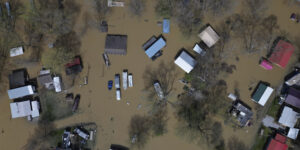Insurers jumped in markets from Europe to Florida amid signs that predictions about Hurricane Irma’s damage were excessively dire.
Giant reinsurers like Swiss Re and Munich Re, which shoulder risks for local insurers around the world, posted their biggest gains of the year Monday. Universal Insurance Holdings Inc., the largest provider of residential coverage in Florida, jumped 15 percent at 9:31 a.m. in New York, regaining some of its losses from last week.
The storm shifted to Florida’s Gulf Coast over the weekend, sparing Miami a direct hit and prompting risk modeler AIR Worldwide to say the maximum cost for insurers on Irma is $40 billion. Prior worst-case scenarios from analysts and ratings firms were more than $100 billion.
“As destructive as Irma’s path continues to be, we think that the path up the west coast of Florida is better from an insured loss standpoint than projections from mid last week and even Friday,” Ryan Tunis, an analyst at Credit Suisse Group AG, said in a note to investors. “While Irma may be costly to reinsurer book values, Irma alone should not trigger the need for additional capital.”
Aspen Insurance Holdings Ltd. led gains among Bermuda-based carriers, surging 13 percent. Validus Holdings Ltd., Everest Re Group Ltd. and XL Group Ltd. each jumped at least 6 percent.
“There will be loss-driven price increases in certain areas of the market” next year, Hannover Re Chief Executive Officer Ulrich Wallin said at a press conference in Monte Carlo where reinsurers are holding their annual meeting with brokers and clients. “I don’t think we’ll have a market dislocation, but the hurricane season lasts until the end of November, and climate conditions seem to be quite conducive to hurricanes.”
Estimates on claims from Irma still varied widely on Monday. Risk modeling firm AIR Worldwide on Monday estimated insured losses in the U.S. at between $20 billion and $40 billion, while Enki Research sees them at about $19 billion. There’s a 10 percent chance of insured wind losses from Irma exceeding $60 billion, catastrophe risk modeling firm RMS said on its website on Sunday.
“This threshold continues to decrease from previous guidance, reflecting the increasing probability of a predominantly offshore storm track,” the company said.
Flooding, Wind
The storm’s shift helped the insurance industry in several ways. The value of real estate is less in the Tampa region than in Miami. Also, the property mix in Tampa is weighted more heavily to residences rather than commercial buildings. Private insurers generally don’t cover flooding in homes, because those risks are handled by a federal government program.
“It’s unclear at this point what portion of the damage will be caused by storm-surge flooding versus wind,” Tunis wrote. “But it’s a higher percentage than what we think the market was expecting on Friday.”
Hannover was the biggest gainer in Stoxx index for the industry in Europe, climbing 4.9 percent. Swiss Re and Munich Re rose almost 4 percent.
“Irma certainly is not as bad as it was feared,” Inga Beale, CEO of insurance market Lloyd’s of London, said in an interview. “However, we’re still in hurricane season, there are other natural disasters to consider and there is a long way to go before the year is up.”
Irma on Sunday became the second major hurricane to hit the U.S. within weeks, following Hurricane Harvey, which smashed ashore in Texas and flooded parts of Houston. The industry will also face claims from the earthquake that struck Mexico.




















 The Workplace Is Changing; So Are the Risks for Employment Discrimination Claims
The Workplace Is Changing; So Are the Risks for Employment Discrimination Claims  Insurance Industry Contemplates Knock-On Effect of Tariffs to Claims, Consumers
Insurance Industry Contemplates Knock-On Effect of Tariffs to Claims, Consumers  How Cincinnati Insurance Does E&S
How Cincinnati Insurance Does E&S  Allstate: How Can You Save on Auto Insurance?
Allstate: How Can You Save on Auto Insurance? 









